| Listing 1 - 7 of 7 |
Sort by
|
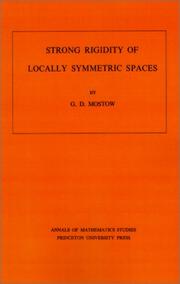
ISBN: 0691081360 1400881838 9780691081366 Year: 1973 Volume: 78 Publisher: Princeton (N.J.): Princeton university press,
Abstract | Keywords | Export | Availability | Bookmark
 Loading...
Loading...Choose an application
- Reference Manager
- EndNote
- RefWorks (Direct export to RefWorks)
Locally symmetric spaces are generalizations of spaces of constant curvature. In this book the author presents the proof of a remarkable phenomenon, which he calls "strong rigidity": this is a stronger form of the deformation rigidity that has been investigated by Selberg, Calabi-Vesentini, Weil, Borel, and Raghunathan.The proof combines the theory of semi-simple Lie groups, discrete subgroups, the geometry of E. Cartan's symmetric Riemannian spaces, elements of ergodic theory, and the fundamental theorem of projective geometry as applied to Tit's geometries. In his proof the author introduces two new notions having independent interest: one is "pseudo-isometries"; the other is a notion of a quasi-conformal mapping over the division algebra K (K equals real, complex, quaternion, or Cayley numbers). The author attempts to make the account accessible to readers with diverse backgrounds, and the book contains capsule descriptions of the various theories that enter the proof.
Differential geometry. Global analysis --- Riemannian manifolds --- Symmetric spaces --- Rigidity (Geometry) --- 512 --- Lie groups --- Geometric rigidity --- Rigidity theorem --- Discrete geometry --- Spaces, Symmetric --- Geometry, Differential --- Manifolds, Riemannian --- Riemannian space --- Space, Riemannian --- Manifolds (Mathematics) --- Groups, Lie --- Lie algebras --- Topological groups --- Algebra --- Lie groups. --- Riemannian manifolds. --- Symmetric spaces. --- Rigidity (Geometry). --- 512 Algebra --- Addition. --- Adjoint representation. --- Affine space. --- Approximation. --- Automorphism. --- Axiom. --- Big O notation. --- Boundary value problem. --- Cohomology. --- Compact Riemann surface. --- Compact space. --- Conjecture. --- Constant curvature. --- Corollary. --- Counterexample. --- Covering group. --- Covering space. --- Curvature. --- Diameter. --- Diffeomorphism. --- Differentiable function. --- Dimension. --- Direct product. --- Division algebra. --- Ergodicity. --- Erlangen program. --- Existence theorem. --- Exponential function. --- Finitely generated group. --- Fundamental domain. --- Fundamental group. --- Geometry. --- Half-space (geometry). --- Hausdorff distance. --- Hermitian matrix. --- Homeomorphism. --- Homomorphism. --- Hyperplane. --- Identity matrix. --- Inner automorphism. --- Isometry group. --- Jordan algebra. --- Matrix multiplication. --- Metric space. --- Morphism. --- Möbius transformation. --- Normal subgroup. --- Normalizing constant. --- Partially ordered set. --- Permutation. --- Projective space. --- Riemann surface. --- Riemannian geometry. --- Sectional curvature. --- Self-adjoint. --- Set function. --- Smoothness. --- Stereographic projection. --- Subgroup. --- Subset. --- Summation. --- Symmetric space. --- Tangent space. --- Tangent vector. --- Theorem. --- Topology. --- Tubular neighborhood. --- Two-dimensional space. --- Unit sphere. --- Vector group. --- Weyl group. --- Riemann, Variétés de --- Lie, Groupes de --- Geometrie differentielle globale --- Varietes riemanniennes
Book
ISBN: 0691643024 1400853656 9781400853656 9781306988988 1306988985 0691082510 9780691615622 Year: 1981 Publisher: Princeton, N.J. Princeton University Press
Abstract | Keywords | Export | Availability | Bookmark
 Loading...
Loading...Choose an application
- Reference Manager
- EndNote
- RefWorks (Direct export to RefWorks)
The purpose of this book is to provide a self-contained account, accessible to the non-specialist, of algebra necessary for the solution of the integrability problem for transitive pseudogroup structures.Originally published in 1981.The Princeton Legacy Library uses the latest print-on-demand technology to again make available previously out-of-print books from the distinguished backlist of Princeton University Press. These editions preserve the original texts of these important books while presenting them in durable paperback and hardcover editions. The goal of the Princeton Legacy Library is to vastly increase access to the rich scholarly heritage found in the thousands of books published by Princeton University Press since its founding in 1905.
Lie algebras. --- Ideals (Algebra) --- Pseudogroups. --- Global analysis (Mathematics) --- Lie groups --- Algebraic ideals --- Algebraic fields --- Rings (Algebra) --- Algebras, Lie --- Algebra, Abstract --- Algebras, Linear --- Lie algebras --- Pseudogroups --- 512.81 --- 512.81 Lie groups --- Ideals (Algebra). --- Lie, Algèbres de. --- Idéaux (algèbre) --- Pseudogroupes (mathématiques) --- Ordered algebraic structures --- Analytical spaces --- Addition. --- Adjoint representation. --- Algebra homomorphism. --- Algebra over a field. --- Algebraic extension. --- Algebraic structure. --- Analytic function. --- Associative algebra. --- Automorphism. --- Bilinear form. --- Bilinear map. --- Cartesian product. --- Closed graph theorem. --- Codimension. --- Coefficient. --- Cohomology. --- Commutative ring. --- Commutator. --- Compact space. --- Complex conjugate. --- Complexification (Lie group). --- Complexification. --- Conjecture. --- Constant term. --- Continuous function. --- Contradiction. --- Corollary. --- Counterexample. --- Diagram (category theory). --- Differentiable manifold. --- Differential form. --- Differential operator. --- Dimension (vector space). --- Dimension. --- Direct sum. --- Discrete space. --- Donald C. Spencer. --- Dual basis. --- Embedding. --- Epimorphism. --- Existential quantification. --- Exterior (topology). --- Exterior algebra. --- Exterior derivative. --- Faithful representation. --- Formal power series. --- Graded Lie algebra. --- Ground field. --- Homeomorphism. --- Homomorphism. --- Hyperplane. --- I0. --- Indeterminate (variable). --- Infinitesimal transformation. --- Injective function. --- Integer. --- Integral domain. --- Invariant subspace. --- Invariant theory. --- Isotropy. --- Jacobi identity. --- Levi decomposition. --- Lie algebra. --- Linear algebra. --- Linear map. --- Linear subspace. --- Local diffeomorphism. --- Mathematical induction. --- Maximal ideal. --- Module (mathematics). --- Monomorphism. --- Morphism. --- Natural transformation. --- Non-abelian. --- Partial differential equation. --- Pseudogroup. --- Pullback (category theory). --- Simple Lie group. --- Space form. --- Special case. --- Subalgebra. --- Submanifold. --- Subring. --- Summation. --- Symmetric algebra. --- Symplectic vector space. --- Telescoping series. --- Theorem. --- Topological algebra. --- Topological space. --- Topological vector space. --- Topology. --- Transitive relation. --- Triviality (mathematics). --- Unit vector. --- Universal enveloping algebra. --- Vector bundle. --- Vector field. --- Vector space. --- Weak topology. --- Lie, Algèbres de. --- Idéaux (algèbre) --- Pseudogroupes (mathématiques)
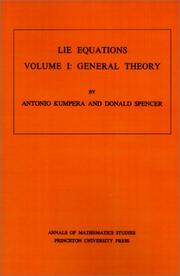
ISBN: 0691081115 9780691081113 1400881730 Year: 1972 Volume: 73 Publisher: Princeton, N.J.
Abstract | Keywords | Export | Availability | Bookmark
 Loading...
Loading...Choose an application
- Reference Manager
- EndNote
- RefWorks (Direct export to RefWorks)
In this monograph the authors redevelop the theory systematically using two different approaches. A general mechanism for the deformation of structures on manifolds was developed by Donald Spencer ten years ago. A new version of that theory, based on the differential calculus in the analytic spaces of Grothendieck, was recently given by B. Malgrange. The first approach adopts Malgrange's idea in defining jet sheaves and linear operators, although the brackets and the non-linear theory arc treated in an essentially different manner. The second approach is based on the theory of derivations, and its relationship to the first is clearly explained. The introduction describes examples of Lie equations and known integrability theorems, and gives applications of the theory to be developed in the following chapters and in the subsequent volume.
Differential geometry. Global analysis --- Lie groups --- Lie algebras --- Differential equations --- Groupes de Lie --- Algèbres de Lie --- Equations différentielles --- 514.76 --- Groups, Lie --- Symmetric spaces --- Topological groups --- Algebras, Lie --- Algebra, Abstract --- Algebras, Linear --- Equations, Differential --- Bessel functions --- Calculus --- Geometry of differentiable manifolds and of their submanifolds --- Differential equations. --- Lie algebras. --- Lie groups. --- 517.91 Differential equations --- 514.76 Geometry of differentiable manifolds and of their submanifolds --- Algèbres de Lie --- Equations différentielles --- 517.91. --- Numerical solutions --- Surfaces, Deformation of --- Surfaces (mathématiques) --- Déformation --- Pseudogroups. --- Pseudogroupes (mathématiques) --- 517.91 --- Adjoint representation. --- Adjoint. --- Affine transformation. --- Alexander Grothendieck. --- Analytic function. --- Associative algebra. --- Atlas (topology). --- Automorphism. --- Bernhard Riemann. --- Big O notation. --- Bundle map. --- Category of topological spaces. --- Cauchy–Riemann equations. --- Coefficient. --- Commutative diagram. --- Commutator. --- Complex conjugate. --- Complex group. --- Complex manifold. --- Computation. --- Conformal map. --- Continuous function. --- Coordinate system. --- Corollary. --- Cotangent bundle. --- Curvature tensor. --- Deformation theory. --- Derivative. --- Diagonal. --- Diffeomorphism. --- Differentiable function. --- Differential form. --- Differential operator. --- Differential structure. --- Direct proof. --- Direct sum. --- Ellipse. --- Endomorphism. --- Equation. --- Exact sequence. --- Exactness. --- Existential quantification. --- Exponential function. --- Exponential map (Riemannian geometry). --- Exterior derivative. --- Fiber bundle. --- Fibration. --- Frame bundle. --- Frobenius theorem (differential topology). --- Frobenius theorem (real division algebras). --- Group isomorphism. --- Groupoid. --- Holomorphic function. --- Homeomorphism. --- Integer. --- J-invariant. --- Jacobian matrix and determinant. --- Jet bundle. --- Linear combination. --- Linear map. --- Manifold. --- Maximal ideal. --- Model category. --- Morphism. --- Nonlinear system. --- Open set. --- Parameter. --- Partial derivative. --- Partial differential equation. --- Pointwise. --- Presheaf (category theory). --- Pseudo-differential operator. --- Pseudogroup. --- Quantity. --- Regular map (graph theory). --- Requirement. --- Riemann surface. --- Right inverse. --- Scalar multiplication. --- Sheaf (mathematics). --- Special case. --- Structure tensor. --- Subalgebra. --- Subcategory. --- Subgroup. --- Submanifold. --- Subset. --- Tangent bundle. --- Tangent space. --- Tangent vector. --- Tensor field. --- Tensor product. --- Theorem. --- Torsion tensor. --- Transpose. --- Variable (mathematics). --- Vector bundle. --- Vector field. --- Vector space. --- Volume element. --- Surfaces (mathématiques) --- Déformation --- Analyse sur une variété
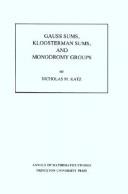
ISBN: 0691084335 0691084327 1400882125 Year: 1988 Volume: vol 116 Publisher: Princeton : Princeton University Press,
Abstract | Keywords | Export | Availability | Bookmark
 Loading...
Loading...Choose an application
- Reference Manager
- EndNote
- RefWorks (Direct export to RefWorks)
The study of exponential sums over finite fields, begun by Gauss nearly two centuries ago, has been completely transformed in recent years by advances in algebraic geometry, culminating in Deligne's work on the Weil Conjectures. It now appears as a very attractive mixture of algebraic geometry, representation theory, and the sheaf-theoretic incarnations of such standard constructions of classical analysis as convolution and Fourier transform. The book is simultaneously an account of some of these ideas, techniques, and results, and an account of their application to concrete equidistribution questions concerning Kloosterman sums and Gauss sums.
Group theory --- Algebraic geometry --- Number theory --- 511.33 --- Analytical and multiplicative number theory. Asymptotics. Sieves etc. --- 511.33 Analytical and multiplicative number theory. Asymptotics. Sieves etc. --- Gaussian sums --- Homology theory --- Kloosterman sums --- Monodromy groups --- Kloostermann sums --- Sums, Kloosterman --- Sums, Kloostermann --- Exponential sums --- Cohomology theory --- Contrahomology theory --- Algebraic topology --- Gauss sums --- Sums, Gaussian --- Analytical and multiplicative number theory. Asymptotics. Sieves etc --- Gaussian sums. --- Kloosterman sums. --- Homology theory. --- Monodromy groups. --- Number theory. --- Nombres, Théorie des. --- Exponential sums. --- Sommes exponentielles. --- Arithmetic --- Arithmétique --- Geometry, Algebraic. --- Géométrie algébrique --- Abelian category. --- Absolute Galois group. --- Absolute value. --- Additive group. --- Adjoint representation. --- Affine variety. --- Algebraic group. --- Automorphic form. --- Automorphism. --- Big O notation. --- Cartan subalgebra. --- Characteristic polynomial. --- Classification theorem. --- Coefficient. --- Cohomology. --- Cokernel. --- Combination. --- Commutator. --- Compactification (mathematics). --- Complex Lie group. --- Complex number. --- Conjugacy class. --- Continuous function. --- Convolution theorem. --- Convolution. --- Determinant. --- Diagonal matrix. --- Dimension (vector space). --- Direct sum. --- Dual basis. --- Eigenvalues and eigenvectors. --- Empty set. --- Endomorphism. --- Equidistribution theorem. --- Estimation. --- Exactness. --- Existential quantification. --- Exponential sum. --- Exterior algebra. --- Faithful representation. --- Finite field. --- Finite group. --- Four-dimensional space. --- Frobenius endomorphism. --- Fundamental group. --- Fundamental representation. --- Galois group. --- Gauss sum. --- Homomorphism. --- Integer. --- Irreducibility (mathematics). --- Isomorphism class. --- Kloosterman sum. --- L-function. --- Leray spectral sequence. --- Lie algebra. --- Lie theory. --- Maximal compact subgroup. --- Method of moments (statistics). --- Monodromy theorem. --- Monodromy. --- Morphism. --- Multiplicative group. --- Natural number. --- Nilpotent. --- Open problem. --- P-group. --- Pairing. --- Parameter space. --- Parameter. --- Partially ordered set. --- Perfect field. --- Point at infinity. --- Polynomial ring. --- Prime number. --- Quotient group. --- Representation ring. --- Representation theory. --- Residue field. --- Riemann hypothesis. --- Root of unity. --- Sheaf (mathematics). --- Simple Lie group. --- Skew-symmetric matrix. --- Smooth morphism. --- Special case. --- Spin representation. --- Subgroup. --- Support (mathematics). --- Symmetric matrix. --- Symplectic group. --- Symplectic vector space. --- Tensor product. --- Theorem. --- Trace (linear algebra). --- Trivial representation. --- Variable (mathematics). --- Weil conjectures. --- Weyl character formula. --- Zariski topology. --- Geometry, Algebraic
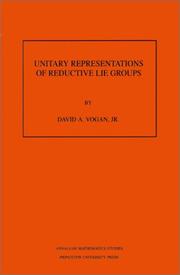
ISBN: 0691084815 0691084823 1400882389 9780691084824 9780691084817 Year: 1987 Publisher: Princeton (N.J.): Princeton university press,
Abstract | Keywords | Export | Availability | Bookmark
 Loading...
Loading...Choose an application
- Reference Manager
- EndNote
- RefWorks (Direct export to RefWorks)
This book is an expanded version of the Hermann Weyl Lectures given at the Institute for Advanced Study in January 1986. It outlines some of what is now known about irreducible unitary representations of real reductive groups, providing fairly complete definitions and references, and sketches (at least) of most proofs. The first half of the book is devoted to the three more or less understood constructions of such representations: parabolic induction, complementary series, and cohomological parabolic induction. This culminates in the description of all irreducible unitary representation of the general linear groups. For other groups, one expects to need a new construction, giving "unipotent representations." The latter half of the book explains the evidence for that expectation and suggests a partial definition of unipotent representations.
Lie groups --- Representations of Lie groups --- Lie groups. --- Representations of Lie groups. --- 512.81 --- Groups, Lie --- Lie algebras --- Symmetric spaces --- Topological groups --- 512.81 Lie groups --- Abelian group. --- Adjoint representation. --- Annihilator (ring theory). --- Atiyah–Singer index theorem. --- Automorphic form. --- Automorphism. --- Cartan subgroup. --- Circle group. --- Class function (algebra). --- Classification theorem. --- Cohomology. --- Commutator subgroup. --- Complete metric space. --- Complex manifold. --- Conjugacy class. --- Cotangent space. --- Dimension (vector space). --- Discrete series representation. --- Dixmier conjecture. --- Dolbeault cohomology. --- Duality (mathematics). --- Eigenvalues and eigenvectors. --- Exponential map (Lie theory). --- Exponential map (Riemannian geometry). --- Exterior algebra. --- Function space. --- Group homomorphism. --- Harmonic analysis. --- Hecke algebra. --- Hilbert space. --- Hodge theory. --- Holomorphic function. --- Holomorphic vector bundle. --- Homogeneous space. --- Homomorphism. --- Induced representation. --- Infinitesimal character. --- Inner automorphism. --- Invariant subspace. --- Irreducibility (mathematics). --- Irreducible representation. --- Isometry group. --- Isometry. --- K-finite. --- Kazhdan–Lusztig polynomial. --- Langlands decomposition. --- Lie algebra cohomology. --- Lie algebra representation. --- Lie algebra. --- Lie group action. --- Lie group. --- Mathematical induction. --- Maximal compact subgroup. --- Measure (mathematics). --- Minkowski space. --- Nilpotent group. --- Orbit method. --- Orthogonal group. --- Parabolic induction. --- Principal homogeneous space. --- Principal series representation. --- Projective space. --- Pseudo-Riemannian manifold. --- Pullback (category theory). --- Ramanujan–Petersson conjecture. --- Reductive group. --- Regularity theorem. --- Representation of a Lie group. --- Representation theorem. --- Representation theory. --- Riemann sphere. --- Riemannian manifold. --- Schwartz space. --- Semisimple Lie algebra. --- Sheaf (mathematics). --- Sign (mathematics). --- Special case. --- Spectral theory. --- Sub"ient. --- Subgroup. --- Support (mathematics). --- Symplectic geometry. --- Symplectic group. --- Symplectic vector space. --- Tangent space. --- Tautological bundle. --- Theorem. --- Topological group. --- Topological space. --- Trivial representation. --- Unitary group. --- Unitary matrix. --- Unitary representation. --- Universal enveloping algebra. --- Vector bundle. --- Weyl algebra. --- Weyl character formula. --- Weyl group. --- Zariski's main theorem. --- Zonal spherical function. --- Représentations de groupes de Lie --- Groupes de lie --- Representation des groupes de lie
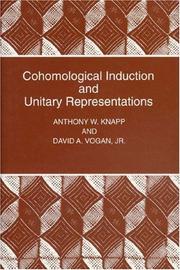
ISBN: 0691037566 1400883938 Year: 1995 Publisher: Princeton : Princeton University Press,
Abstract | Keywords | Export | Availability | Bookmark
 Loading...
Loading...Choose an application
- Reference Manager
- EndNote
- RefWorks (Direct export to RefWorks)
This book offers a systematic treatment--the first in book form--of the development and use of cohomological induction to construct unitary representations. George Mackey introduced induction in 1950 as a real analysis construction for passing from a unitary representation of a closed subgroup of a locally compact group to a unitary representation of the whole group. Later a parallel construction using complex analysis and its associated co-homology theories grew up as a result of work by Borel, Weil, Harish-Chandra, Bott, Langlands, Kostant, and Schmid. Cohomological induction, introduced by Zuckerman, is an algebraic analog that is technically more manageable than the complex-analysis construction and leads to a large repertory of irreducible unitary representations of reductive Lie groups. The book, which is accessible to students beyond the first year of graduate school, will interest mathematicians and physicists who want to learn about and take advantage of the algebraic side of the representation theory of Lie groups. Cohomological Induction and Unitary Representations develops the necessary background in representation theory and includes an introductory chapter of motivation, a thorough treatment of the "translation principle," and four appendices on algebra and analysis.
512.73 --- Harmonic analysis --- Homology theory --- Representations of groups --- Semisimple Lie groups --- Semi-simple Lie groups --- Lie groups --- Group representation (Mathematics) --- Groups, Representation theory of --- Group theory --- Cohomology theory --- Contrahomology theory --- Algebraic topology --- Analysis (Mathematics) --- Functions, Potential --- Potential functions --- Banach algebras --- Calculus --- Mathematical analysis --- Mathematics --- Bessel functions --- Fourier series --- Harmonic functions --- Time-series analysis --- Cohomology theory of algebraic varieties and schemes --- 512.73 Cohomology theory of algebraic varieties and schemes --- Lie algebras. --- Lie, Algèbres de. --- Semisimple Lie groups. --- Representations of groups. --- Homology theory. --- Harmonic analysis. --- Représentations d'algèbres de Lie --- Representations of Lie algebras --- Abelian category. --- Additive identity. --- Adjoint representation. --- Algebra homomorphism. --- Associative algebra. --- Associative property. --- Automorphic form. --- Automorphism. --- Banach space. --- Basis (linear algebra). --- Bilinear form. --- Cartan pair. --- Cartan subalgebra. --- Cartan subgroup. --- Cayley transform. --- Character theory. --- Classification theorem. --- Cohomology. --- Commutative property. --- Complexification (Lie group). --- Composition series. --- Conjugacy class. --- Conjugate transpose. --- Diagram (category theory). --- Dimension (vector space). --- Dirac delta function. --- Discrete series representation. --- Dolbeault cohomology. --- Eigenvalues and eigenvectors. --- Explicit formulae (L-function). --- Fubini's theorem. --- Functor. --- Gregg Zuckerman. --- Grothendieck group. --- Grothendieck spectral sequence. --- Haar measure. --- Hecke algebra. --- Hermite polynomials. --- Hermitian matrix. --- Hilbert space. --- Hilbert's basis theorem. --- Holomorphic function. --- Hopf algebra. --- Identity component. --- Induced representation. --- Infinitesimal character. --- Inner product space. --- Invariant subspace. --- Invariant theory. --- Inverse limit. --- Irreducible representation. --- Isomorphism class. --- Langlands classification. --- Langlands decomposition. --- Lexicographical order. --- Lie algebra. --- Linear extension. --- Linear independence. --- Mathematical induction. --- Matrix group. --- Module (mathematics). --- Monomial. --- Noetherian. --- Orthogonal transformation. --- Parabolic induction. --- Penrose transform. --- Projection (linear algebra). --- Reductive group. --- Representation theory. --- Semidirect product. --- Semisimple Lie algebra. --- Sesquilinear form. --- Sheaf cohomology. --- Skew-symmetric matrix. --- Special case. --- Spectral sequence. --- Stein manifold. --- Sub"ient. --- Subalgebra. --- Subcategory. --- Subgroup. --- Submanifold. --- Summation. --- Symmetric algebra. --- Symmetric space. --- Symmetrization. --- Tensor product. --- Theorem. --- Uniqueness theorem. --- Unitary group. --- Unitary operator. --- Unitary representation. --- Upper and lower bounds. --- Verma module. --- Weight (representation theory). --- Weyl character formula. --- Weyl group. --- Weyl's theorem. --- Zorn's lemma. --- Zuckerman functor. --- Lie, Algèbres de. --- Représentations d'algèbres de Lie
Book
ISBN: 0691082464 069161136X 1400871131 069163937X 9780691082462 Year: 1979 Publisher: Princeton (N.J.) : Princeton university press,
Abstract | Keywords | Export | Availability | Bookmark
 Loading...
Loading...Choose an application
- Reference Manager
- EndNote
- RefWorks (Direct export to RefWorks)
Based on a series of lectures given by Harish-Chandra at the Institute for Advanced Study in 1971-1973, this book provides an introduction to the theory of harmonic analysis on reductive p-adic groups.Originally published in 1979.The Princeton Legacy Library uses the latest print-on-demand technology to again make available previously out-of-print books from the distinguished backlist of Princeton University Press. These editions preserve the original texts of these important books while presenting them in durable paperback and hardcover editions. The goal of the Princeton Legacy Library is to vastly increase access to the rich scholarly heritage found in the thousands of books published by Princeton University Press since its founding in 1905.
512.74 --- p-adic groups --- Banach algebras --- Groups, p-adic --- Algebraic groups. Abelian varieties --- p-adic groups. --- 512.74 Algebraic groups. Abelian varieties --- P-adic groups. --- Harmonic analysis. Fourier analysis --- Harmonic analysis --- Analysis (Mathematics) --- Functions, Potential --- Potential functions --- Calculus --- Mathematical analysis --- Mathematics --- Bessel functions --- Fourier series --- Harmonic functions --- Time-series analysis --- Group theory --- Harmonic analysis. --- Adjoint representation. --- Admissible representation. --- Algebra homomorphism. --- Algebraic group. --- Analytic continuation. --- Analytic function. --- Associative property. --- Automorphic form. --- Automorphism. --- Banach space. --- Bijection. --- Bilinear form. --- Borel subgroup. --- Cartan subgroup. --- Central simple algebra. --- Characteristic function (probability theory). --- Characterization (mathematics). --- Class function (algebra). --- Commutative property. --- Compact space. --- Composition series. --- Conjugacy class. --- Corollary. --- Dimension (vector space). --- Discrete series representation. --- Division algebra. --- Double coset. --- Eigenvalues and eigenvectors. --- Endomorphism. --- Epimorphism. --- Equivalence class. --- Equivalence relation. --- Existential quantification. --- Factorization. --- Fourier series. --- Function (mathematics). --- Functional equation. --- Fundamental domain. --- Fundamental lemma (Langlands program). --- G-module. --- Group isomorphism. --- Haar measure. --- Hecke algebra. --- Holomorphic function. --- Identity element. --- Induced representation. --- Inner automorphism. --- Lebesgue measure. --- Levi decomposition. --- Lie algebra. --- Locally constant function. --- Locally integrable function. --- Mathematical induction. --- Matrix coefficient. --- Maximal compact subgroup. --- Meromorphic function. --- Module (mathematics). --- Module homomorphism. --- Open set. --- Order of integration (calculus). --- Orthogonal complement. --- P-adic number. --- Pole (complex analysis). --- Product measure. --- Projection (linear algebra). --- Quotient module. --- Quotient space (topology). --- Radon measure. --- Reductive group. --- Representation of a Lie group. --- Representation theorem. --- Representation theory. --- Ring homomorphism. --- Schwartz space. --- Semisimple algebra. --- Separable extension. --- Sesquilinear form. --- Set (mathematics). --- Sign (mathematics). --- Square-integrable function. --- Sub"ient. --- Subalgebra. --- Subgroup. --- Subset. --- Summation. --- Support (mathematics). --- Surjective function. --- Tempered representation. --- Tensor product. --- Theorem. --- Topological group. --- Topological space. --- Topology. --- Trace (linear algebra). --- Transitive relation. --- Unitary representation. --- Universal enveloping algebra. --- Variable (mathematics). --- Vector space. --- Analyse harmonique (mathématiques)
| Listing 1 - 7 of 7 |
Sort by
|

 Search
Search Feedback
Feedback About UniCat
About UniCat  Help
Help News
News